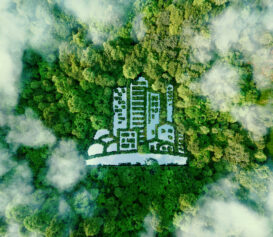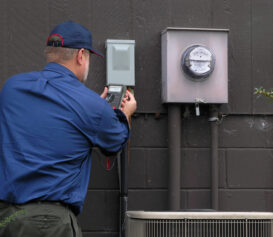With several new filings coming due for the first time plus installations, tests, and more, we had to ask – is 2025 the biggest year in NYC compliance?
Here’s just some of what owners and managers can expect starting next year:
First-Time Sustainability Filings
Local Law 97
The most prolific compliance update in 2025 is the first-ever filing for Local Law 97 reports.
May 1, 2025 is the first filing due date for many covered buildings. It’s also the first – and only – filing due date for properties on the Prescriptive List.
There’s two watchouts here:
- Properties may face fines for failing to stay under emissions limits – specifically, $268 per ton of carbon dioxide over the limit
- The 2025 reports will be filed with data based on the 2024 calendar year, and every year following
- Emission limits are set to drop in 2030, which may expose more properties to these penalties
- Properties may also face fines for failing to file – specifically, monthly fines calculated on the building’s size – “no greater than an amount equal to the gross floor area of such covered building, multiplied by $0.50″
- This is different than other regulations, which commonly have flat fees for failure to file (elevators, boilers, parking structures, gas piping inspections, etc.)
The city has hired to help manage enforcement here, given the unique nature of fines in both cases. You can read more about it in our post on Local Law 97 enforcement.
Need help with Local Law 97? Reach out to your Customer Success Manager at SiteCompli – we’re happy to connect you with experts who can answer questions and help you for specific properties.
Local Law 88
Local Law 97 isn’t the only sustainability filing due starting May 1, 2025.
Reports for Local Law 88 – a requirement to upgrade lighting systems in commercial buildings and common areas of residential buildings, and install electrical sub-meters in tenant spaces by January 1, 2025 – are also due on May 1st.
This law applies to properties 25,000 sq. ft. and larger, with some exceptions noted below. You may see some resources referencing a 50,000 sq. ft. threshold, but this was updated years later to align with the requirements for most covered buildings (like Local Laws 84 & 97).
Per the code, covered tenant spaces for sub-metering are defined as:
COVERED TENANT SPACE. (i) A tenant space larger than 5,000 gross square feet (465 m2) on one or more floors of a covered building let or sublet to the same person, or (ii) a floor, of a covered building, larger than 5,000 gross square feet (465 m2) consisting of tenant spaces let or sublet to two or more different persons.
Exception: The term “covered tenant space” shall not include dwelling units classified in occupancy group R-2 or R-3.
Additionally, here are exemptions for lighting upgrades, from the text of the law:
2. No upgrade is required for the lighting system within dwelling units classified in occupancy group R-2 or R-3 or spaces serving such dwelling units, including but not limited to, hallways, laundry rooms, or boiler rooms.
3. No upgrade is required for the lighting system within a space classified in occupancy group A-3 that is within a house of worship.
Per the law, while R-2 and R-3 properties are exempt from certain requirements, they must submit a report to the DOB demonstrating reasons for exemption. No details have been provided yet on the method and structure of these filings, so expect updates soon.
Reporting must include a professional attestation regarding implementation and inspection for compliance. Penalties for failure to submit a report will be $1,500, issued annually until filed. Penalties for failure to install sub-meters in covered tenant spaces will be $500 for each space, assessed annually until all sub-meters are installed.
Residential Requirements Starting & Coming Due
Local Law 31 – XRF Tests
For a few years, owners and managers have been working towards the final due date (August 9, 2025) for XRF tests in all eligible units. Recently, common areas were also made part of the test requirements – with the same due date.
Rules required owners to perform XRF tests in units where children under 6 were known to reside – based on the updated definition of routinely spending 10 hours/week in the unit. But as of August 2024, that frame for compliance will narrow. All tests for all eligible units (presumed lead based on city definitions) must have XRF tests performed by August 9, 2025.
Right now, there’s no mass-submission requirement after the due date for XRF test data, but it’s a best practice to keep test records organized and handy. Following the due date, owners must begin to provide XRF records to HPD when any lead-based paint hazard or turnover-related violations are issued. They must also be provided upon request.
Friction Surfaces
While the major XRF requirement period is coming to an endpoint, more requirements for friction surfaces are kicking off for units with presumed lead-based paint:
- If a child under 6 resides in a unit on January 1, 2025, the owner must abate lead-based paint on door and window friction surfaces, and remediate hazards by July 2027
- If a child under 6 comes to reside in a unit after January 1, 2025, the owner has 3 years from the reside date to perform this work
Read more about XRF tests and friction surfaces in our lead updates post, here.
Local Law 157 – Natural Gas Alarms
While Local Law 157 was introduced in 2016, rules were finalized just a short time ago (following the NFPA standard in 2022).
Local Law 157 requires natural gas alarms in specific residential properties, installed on or before May 1, 2025:
- Private dwellings
- Class A multiple dwellings
- One or more natural gas alarms must be installed in each dwelling for the above property types
- Class B multiple dwellings
- One or more natural gas alarms must be installed in each dwelling, OR;
- A line-operated zoned natural gas detecting system, designed in accordance with NFPA 715-2023 by a registered design professional, must be installed in all public corridors and public spaces
Local Law 157 does not apply to properties that do not have gas piping or gas service.
You can get more details at our post, but depending on the size of your portfolio, this is something you’ll want to start working on now to meet next year’s deadline.
Parking Structures, Take Two
Parking structure inspections for Subcycle B (Manhattan Community Districts 8 and above, and all of Brooklyn) are due by December 31, 2025. Remaining districts (Bronx, Queens, and Staten Island) will be due in the final subcycle, ending in 2027.
That said, structures that have already filed inspections may be performing the next one sooner than they think.
New council laws have approved a shortened inspection cycle for parking structures, narrowing the current 6-year cycle down to 4. While we still don’t know how that’s going to impact subcycle organization or filing timelines, we do know this is going to be a massive change all structure owners will have to adapt to ASAP in order to avoid big fines. Stay tuned for more details, likely released as we get closer to 2027.
Managing Proactive Compliance
All the ongoing requirements – and their changes, and their various cycles – can seem overwhelming. We’ve got you covered.
SiteCompli’s new Compliance Manager features help your team identify what you need to do now – this month, this year, and this cycle – for major city requirements. It’s a great way to manage your proactive compliance filings and ensure nothing falls through the cracks.
Learn more about Compliance Manager here, and reach out to your Customer Success Manager to get started today.
We’re not stopping here – stay tuned for a summer of updates, helpful expert content, and more – all to make sure your team is ready for 2025.




